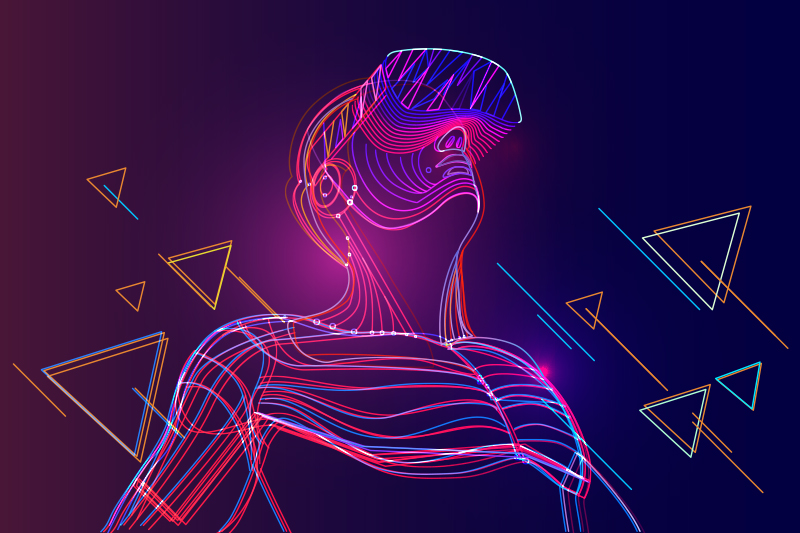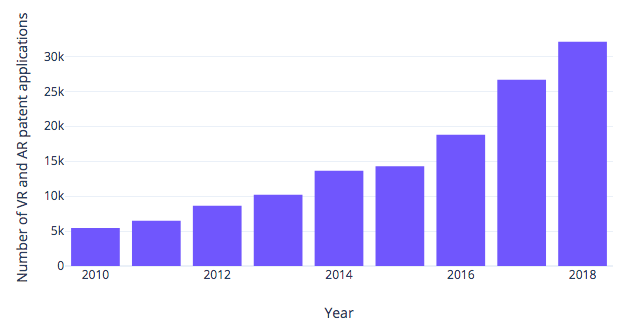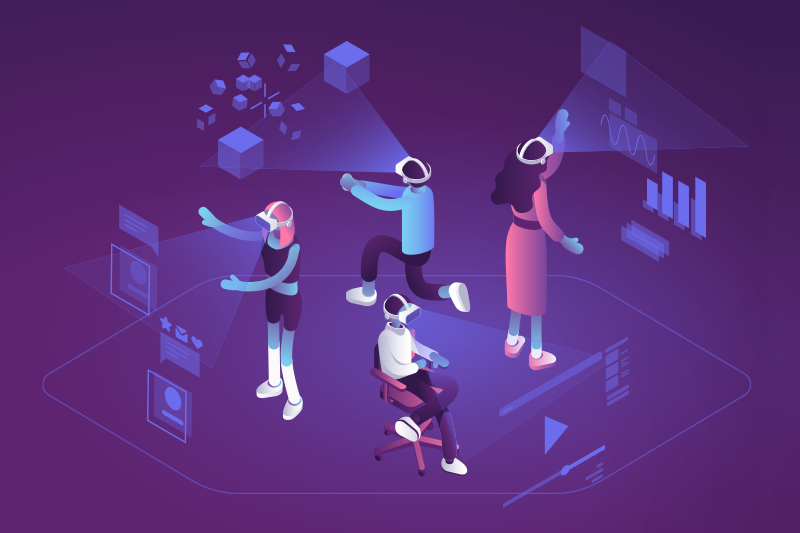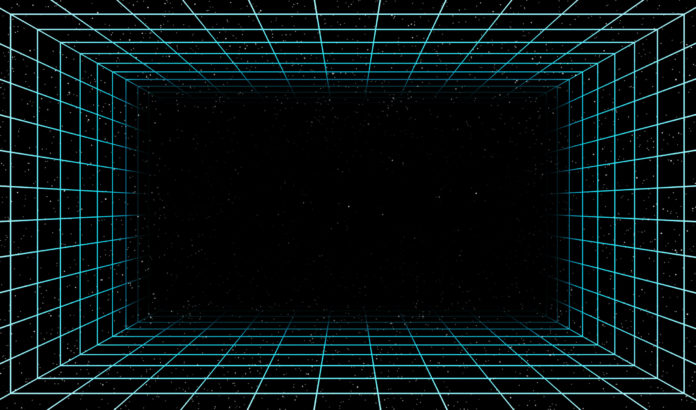02 May 2019
Many early virtual reality devices simply didn’t live up to the hype. Highly-anticipated products like Google Glass and Facebook’s Oculus have quietly faded from popular discussion.
Despite these commercial stumbles, virtual reality — together with its subset, augmented reality — still attracts the attention of top tech innovators. As one example, I recently listened to an episode of The Pitch, where a startup called SVRF portrayed a hopeful future for AR/VR technologies.
And larger tech companies are still exploring improvements to AR/VR technologies. For example, Google has continued to upgrade Google Glass, introducing features like boosted specs and artificial intelligence.
The tech world still views VR and AR as promising emerging technologies. What are the current trends in the VR and AR markets — and where might future growth occur? To address these questions, let’s take a closer look at the patent landscape for VR and AR.

WHAT IS VIRTUAL REALITY AND AUGMENTED REALITY?
Broadly, virtual reality (VR) refers to a computer-generated simulation of a 3D environment that users can interact with in real time. Mass market proliferation of true VR technology has not yet happened.
A subset of VR, augmented reality (AR) digitally enhances the user’s physical environment, and is interactive in real time. The technology is already quite widespread, especially in gaming and entertainment. Best-known examples of AR include Niantic’s mobile app games Pokemon Go and Ingress, as well as Snapchat and Instagram Story filters.
THE FUTURE OF VR AND AR
VR and AR technologies are quickly developing and maturing.
In 2017, Gartner created a Hype Cycle showing AR in the “trough of disillusionment,” and VR approaching the “plateau of productivity.” (Click the thumbnail on the right to see the full graph on Gartner’s website.)
Based on how the Hype Cycle has changed in 2018, it looks like the technology is on a promising path forward. While VR in particular still hasn’t quite become a profitable standalone platform, it should become one soon.
AN OVERVIEW OF VR AND AR PATENT FILINGS
We used data from a report by IPlytics to create a graph showing the number of AR and VR patent applications published in recent years:
Number of VR and AR patent applications per year

A couple of our high-level takeaways from the data:
- The number of patent filings have steadily increased since 2010
- Starting in 2016, there’s been a noticeable increase in the acceleration of patent filings
In fact, VR and AR patent applications have more than doubled in the last four years. This suggests that, even though commercial use of VR and AR hasn’t quite gained strong footing, there’s still growing interest in developing the technology.
WHAT TYPES OF VR AND AR TECHNOLOGY ARE BEING PATENTED?
VR and AR patents typically claim hardware, software, or a combination of both:
- Hardware: Display screens, helmets, head-mounted devices, and so forth
- Software: Digital systems needed to generate the digital environments
There are still lots of questions about whether mass-produced VR technology will ultimately combine hardware and software solutions, or involve only software.

PRACTICAL APPLICATIONS OF VR AND AR
The technologies may still be in the relatively early stages, but VR and AR are poised to impact a wide range of industries beyond entertainment and gaming.
The list is far from exhaustive, but notable practical applications in the works include:
- Healthcare and medicine
- KindVR: Custom VR therapy that helps relieve pain and stress caused by medical reasons
- MindMotion™ PRO: Uses VR to help facilitate neurorehabilitation, speeding up the recovery process
- Medical Realities: Obtain high-quality surgical training via VR — which includes observing surgical procedures in real time
- Military training
- VR simulators: Trains soldiers for combat situations without putting them at physical risk
- Virtual reality exposure therapy: For soldiers dealing with battlefield trauma
- Corporate training
- STRIVR: Immersive, experiential training across diverse fields
- VirtualSpeech: Improve business soft skills in areas such as public speaking, recruitment, and sales
- Design and architecture
- Education
- Nearpod: Interactive lesson plans for K-12 kids, covering a wide range of subjects, including virtual field trips
- Eon Reality: Aims to revolutionize the way teachers use technology in the classroom
- Curiscope: The Virtuali-tee is an AR t-shirt that lets kids peek inside the human anatomy. It’s more fun when somebody is wearing the shirt!
TOP PATENT ASSIGNEES FOR VR AND AR TECHNOLOGY
According to IPlytics, the top five owners of VR and AR patents are:
- Microsoft
- Intel
- Sony
- Samsung
This list isn’t surprising, since these are all big tech companies that file large numbers of patent applications in a wide range of technologies every year. Notably, though, none of these companies are known for any all-star AR/VR products.
VR AND AR PATENT FILINGS BY GEOGRAPHY
According to IPlytics, the top five jurisdictions for VR and AR patent filings are, in order:
- USA
- China
- Europe
- Japan
- South Korea
The list shows that VR and AR patents don’t diverge from the top venues for patent filings across technology sectors. In fact, IPlytics reports that 55% of all AR/VR global patent applications are filed in the USPTO.
FUNDING OPPORTUNITIES FOR VR AND AR
Facebook’s purchase of Oculus may not have been a successful bet, but the move still proved to be a game-changer for the VR and AR industry. According to Re/code, the Oculus acquisition was the catalyst that made the industry pay attention to VR and AR as critical investment opportunities.
Indeed, CB Insights reported in 2017 that disclosed funding for VR and AR had grown 21% in year-over-year deal growth, to over $2.3 billion.
In 2013, disclosed funding for VR and AR had amounted to only $295 million — which meant that funding levels had grown a whopping 790% in just four years.
That said, the AR/VR market is still very much in its early stages. In a separate report, CB Insightspoints out that the majority (59%) of investment deals in VR and AR are for angel/seed rounds.
LOOKING TO BREAK IN TO THE VR AND AR MARKETS?
With the AR/VR industry still in the early stages, there will be many opportunities for innovative tech startups to get their foot in the door.
A successful IP strategy is a critical cornerstone for any high-tech business. If you’ve got valuable VR or AR technology on your hands, you’ll want to partner with an experienced patent attorneywho can help you maximize the value of your IP.
At Henry Patent Law Firm, we’re passionate about helping innovative tech leaders take their businesses to the next level. Contact us now to find out how we can help!

Michael K. Henry, Ph.D.
Michael K. Henry, Ph.D., is a principal and the firm’s founding member. He specializes in creating comprehensive, growth-oriented IP strategies for early-stage tech companies.

